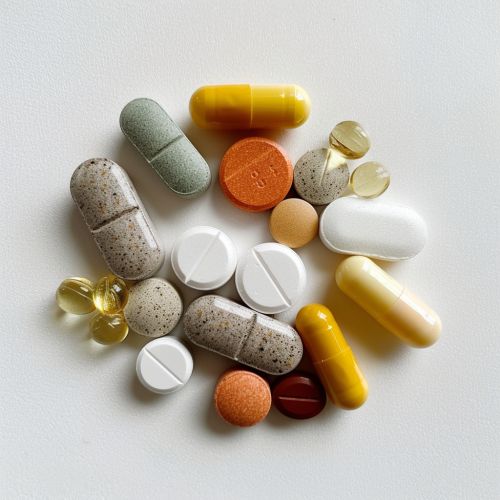Psychotropic Drug: Difference between revisions
No edit summary |
No edit summary |
||
| Line 73: | Line 73: | ||
Research into psychotropic drugs continues to evolve, with ongoing studies aimed at developing more effective and safer medications. Advances in [[pharmacogenomics]] hold promise for personalized medicine, allowing for tailored treatments based on an individual's genetic profile. Additionally, the exploration of novel targets and mechanisms of action may lead to new classes of psychotropic drugs with improved efficacy and reduced side effects. | Research into psychotropic drugs continues to evolve, with ongoing studies aimed at developing more effective and safer medications. Advances in [[pharmacogenomics]] hold promise for personalized medicine, allowing for tailored treatments based on an individual's genetic profile. Additionally, the exploration of novel targets and mechanisms of action may lead to new classes of psychotropic drugs with improved efficacy and reduced side effects. | ||
[[Image:Detail-92977.jpg|thumb|center|Various psychotropic drugs in pill form on a white background.]] | [[Image:Detail-92977.jpg|thumb|center|Various psychotropic drugs in pill form on a white background.|class=only_on_mobile]] | ||
[[Image:Detail-92978.jpg|thumb|center|Various psychotropic drugs in pill form on a white background.|class=only_on_desktop]] | |||
== See Also == | == See Also == | ||
Latest revision as of 21:12, 21 June 2024
Introduction
A psychotropic drug is a chemical substance that affects the central nervous system, altering brain function and resulting in temporary changes in perception, mood, consciousness, and behavior. These drugs are used in the treatment of various mental health disorders, including depression, anxiety, schizophrenia, and bipolar disorder. Psychotropic drugs can be classified into several categories, each with distinct mechanisms of action and therapeutic uses.
Classification of Psychotropic Drugs
Psychotropic drugs are broadly classified into the following categories:
Antidepressants
Antidepressants are medications used primarily to treat major depressive disorder and other conditions, including some anxiety disorders, chronic pain, and certain addictions. They work by altering the levels of neurotransmitters in the brain, such as serotonin, norepinephrine, and dopamine. The main classes of antidepressants include:
- **Selective Serotonin Reuptake Inhibitors (SSRIs)**: These drugs, such as fluoxetine and sertraline, increase the level of serotonin in the brain by inhibiting its reuptake into the presynaptic cell.
- **Serotonin-Norepinephrine Reuptake Inhibitors (SNRIs)**: Examples include venlafaxine and duloxetine, which increase the levels of both serotonin and norepinephrine.
- **Tricyclic Antidepressants (TCAs)**: These older drugs, such as amitriptyline and nortriptyline, affect multiple neurotransmitters and are often used when newer antidepressants are not effective.
- **Monoamine Oxidase Inhibitors (MAOIs)**: These drugs, such as phenelzine and tranylcypromine, inhibit the enzyme monoamine oxidase, which breaks down neurotransmitters like serotonin and norepinephrine.
Antipsychotics
Antipsychotics are used to manage psychosis, including schizophrenia and bipolar disorder. They are divided into two main categories:
- **Typical Antipsychotics**: Also known as first-generation antipsychotics, these drugs, such as haloperidol and chlorpromazine, primarily block dopamine receptors.
- **Atypical Antipsychotics**: Second-generation antipsychotics, such as risperidone and olanzapine, target both dopamine and serotonin receptors and tend to have fewer side effects.
Anxiolytics
Anxiolytics are used to reduce anxiety. The most common class of anxiolytics is benzodiazepines, which include drugs like diazepam and alprazolam. These medications enhance the effect of the neurotransmitter gamma-aminobutyric acid (GABA), resulting in a calming effect.
Mood Stabilizers
Mood stabilizers are used primarily to treat bipolar disorder and include drugs like lithium and certain anticonvulsants such as valproate and lamotrigine. These medications help to stabilize mood swings and prevent manic and depressive episodes.
Stimulants
Stimulants are used to treat conditions such as attention deficit hyperactivity disorder (ADHD) and narcolepsy. They include drugs like methylphenidate and amphetamine. Stimulants increase the levels of certain neurotransmitters, such as dopamine and norepinephrine, in the brain.
Mechanisms of Action
Psychotropic drugs exert their effects through various mechanisms, primarily by interacting with neurotransmitter systems in the brain. These interactions can include:
- **Reuptake Inhibition**: Many antidepressants work by inhibiting the reuptake of neurotransmitters like serotonin and norepinephrine, increasing their availability in the synaptic cleft.
- **Receptor Blockade**: Antipsychotics often work by blocking dopamine receptors, reducing the effects of excess dopamine in conditions like schizophrenia.
- **Enzyme Inhibition**: MAOIs inhibit the enzyme monoamine oxidase, preventing the breakdown of neurotransmitters and increasing their levels.
- **Neurotransmitter Release Enhancement**: Stimulants increase the release of neurotransmitters like dopamine and norepinephrine, enhancing their effects.
Therapeutic Uses
Psychotropic drugs are used to treat a wide range of mental health conditions. Some of the primary therapeutic uses include:
- **Depression**: Antidepressants are the mainstay of treatment for major depressive disorder, helping to alleviate symptoms such as low mood, lack of interest, and fatigue.
- **Anxiety Disorders**: Anxiolytics and certain antidepressants are used to manage conditions like generalized anxiety disorder, panic disorder, and social anxiety disorder.
- **Schizophrenia**: Antipsychotics are essential in the treatment of schizophrenia, helping to manage symptoms such as hallucinations, delusions, and disorganized thinking.
- **Bipolar Disorder**: Mood stabilizers and certain antipsychotics are used to treat the manic and depressive episodes associated with bipolar disorder.
- **ADHD**: Stimulants are commonly prescribed to improve attention, focus, and impulse control in individuals with ADHD.
Side Effects and Risks
While psychotropic drugs can be highly effective, they also carry the risk of side effects and adverse reactions. Some common side effects include:
- **Antidepressants**: Side effects can include nausea, weight gain, sexual dysfunction, and insomnia. TCAs and MAOIs can have more severe side effects, such as cardiac issues and dietary restrictions.
- **Antipsychotics**: Typical antipsychotics can cause extrapyramidal symptoms (EPS), including tremors and rigidity. Atypical antipsychotics may lead to weight gain, diabetes, and metabolic syndrome.
- **Anxiolytics**: Benzodiazepines can cause drowsiness, dizziness, and dependence with long-term use.
- **Mood Stabilizers**: Lithium can cause thyroid and kidney issues, while anticonvulsants may lead to weight gain, tremors, and gastrointestinal problems.
- **Stimulants**: Common side effects include increased heart rate, insomnia, and potential for abuse and dependence.
Pharmacokinetics
The pharmacokinetics of psychotropic drugs, including absorption, distribution, metabolism, and excretion, play a crucial role in their efficacy and safety. Factors such as bioavailability, half-life, and the presence of active metabolites can influence the drug's therapeutic effects and side effects.
- **Absorption**: Most psychotropic drugs are well absorbed from the gastrointestinal tract, but factors like food intake and formulation can affect absorption rates.
- **Distribution**: These drugs are typically distributed widely throughout the body, with many crossing the blood-brain barrier to exert their effects on the central nervous system.
- **Metabolism**: Psychotropic drugs are primarily metabolized in the liver by enzymes such as cytochrome P450. Genetic variations in these enzymes can affect drug metabolism and response.
- **Excretion**: The excretion of psychotropic drugs and their metabolites occurs mainly through the kidneys. Renal function can significantly impact drug clearance and dosing requirements.
Clinical Considerations
When prescribing psychotropic drugs, healthcare providers must consider several factors to optimize treatment outcomes and minimize risks:
- **Patient History**: A thorough medical and psychiatric history is essential to identify potential contraindications and drug interactions.
- **Dosing**: Starting with the lowest effective dose and titrating slowly can help minimize side effects and improve tolerability.
- **Monitoring**: Regular monitoring of therapeutic response and side effects is crucial, especially for drugs with narrow therapeutic windows or significant side effects.
- **Patient Education**: Educating patients about the expected benefits, potential side effects, and the importance of adherence to the prescribed regimen is vital for successful treatment.
Future Directions
Research into psychotropic drugs continues to evolve, with ongoing studies aimed at developing more effective and safer medications. Advances in pharmacogenomics hold promise for personalized medicine, allowing for tailored treatments based on an individual's genetic profile. Additionally, the exploration of novel targets and mechanisms of action may lead to new classes of psychotropic drugs with improved efficacy and reduced side effects.


